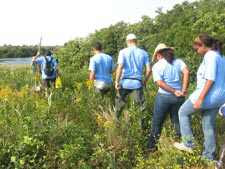 Many Queens residents drive through Broad Channel on their way to Rockaway’s beaches without appreciating the ecological diversity in Jamaica Bay.
Many Queens residents drive through Broad Channel on their way to Rockaway’s beaches without appreciating the ecological diversity in Jamaica Bay.At last week’s first annual BioBlitz, a 24-hour ecological festival based at the Jamaica Bay Wildlife Refuge, located on Broad Channel, diversity was both catalogued and celebrated.
More than 260 people, ranging in age from 2 to 81, worked over the 24-hour period to document the different species near the refuge, as well as in Fort Tilden, located in Rockaway, and in Floyd Bennett Field, in Brooklyn. Over half of the participants were volunteers. While many left early on Saturday morning, some worked straight through.
Beyond listing the different species in the area, participants sought to give scientists the opportunity to study their findings.
“Our main goal is to get researchers out in the park doing basic science, doing research and then getting that translated,” said Nancy Khan, a refuge staff member.
Khan added that the BioBlitz allowed scientists and average citizens to better understand the environment around them in a festive atmosphere.
Participants were greeted with T-shirts, water bottles and an assortment of healthy snacks.
Councilman James Gennaro (D-Fresh Meadows), chairman of the Environmental Protection Committee, helped kick the event off late Friday afternoon.
“It’s critical that we preservemarshland,” he said. “It plays a critical role in protecting the mainland of Queens and Brooklyn, from tidal action to wave action, and also the wetlands, which are incubators for marine life and a lot of terrestrial life as well.”
Coordinated by Queens College Professors Gillian Stewart and John Waldman, the BioBlitz was sponsored in part by the CUNY Institute for Sustainable Cities, Jamaica Bay Institute and the Gateway National Recreation Area.
Among the many excursions BioBlitz offered was Friday evening’s sunset walk, where spectators watched the sun stretch across Jamaica Bay at dusk; Saturday morning’s butterfly search and Saturday’s nature sketching class.
Many college students who were interested in learning more about the bay’s delicate ecological balance volunteered.
“I just want to get involved, even if it’s around the area,” said a graduate student from Brooklyn. Both the student and her friend volunteered to study jellyfish, which involved extracting samples and later identifying species collected.
Queens College biology graduate student Jonelle Orridge came out to study plants, but also to do her part to increase awareness about ecology.
“If (we) reach out to the high schools and make principals aware (of ecological events) students could have a better grasp of what is going on around them.”
Orridge, who is involved in community outreach, believes the best way to learn about the environment is to offer programs at parks and promote events in publications.
By the end of the event, researchers found 665 species, including 166 species of terrestrial plants, 34 insects and 27 species of marine invertebrates.
Congressman Anthony Weiner (D-Forest Hills) helped close the event by saying: “BioBlitz, species by species, item by item, is making us aware just how diverse it (Jamaica Bay) is. We have to do everything to protect it.”












